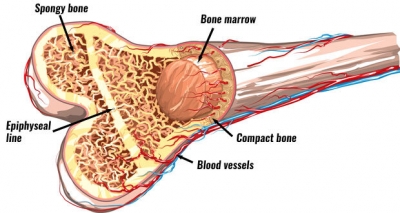
Bone marrow is the spongy tissue inside some of the bones in the body, including the hip and thigh bones. Bone marrow contains immature cells, called stem cells.
Most red blood cells, platelets, and most of the white blood cells are formed in the red marrow. Yellow bone marrow produces fat, cartilage, and bone.
White blood cells survive from a few hours to a few days, platelets for about 10 days, and red blood cells for about 120 days. These cells must be constantly replaced by the bone marrow, as each blood cell has a set life expectancy.
Certain conditions may trigger additional production of blood cells. This may happen when the oxygen content of body tissues is low, if there is loss of blood or anemia, or if the number of red blood cells decreases. If these happen, the kidneys produce and release erythropoietin, a hormone that stimulates the bone marrow to produce more red blood cells.
The bone marrow also produces and releases more white blood cells in response to infections, and more platelets in response to bleeding. If a person experiences serious blood loss, yellow bone marrow can be activated and transformed into red bone marrow.
Healthy bone marrow is important for a range of systems and activities.
Picture Credit : Google

